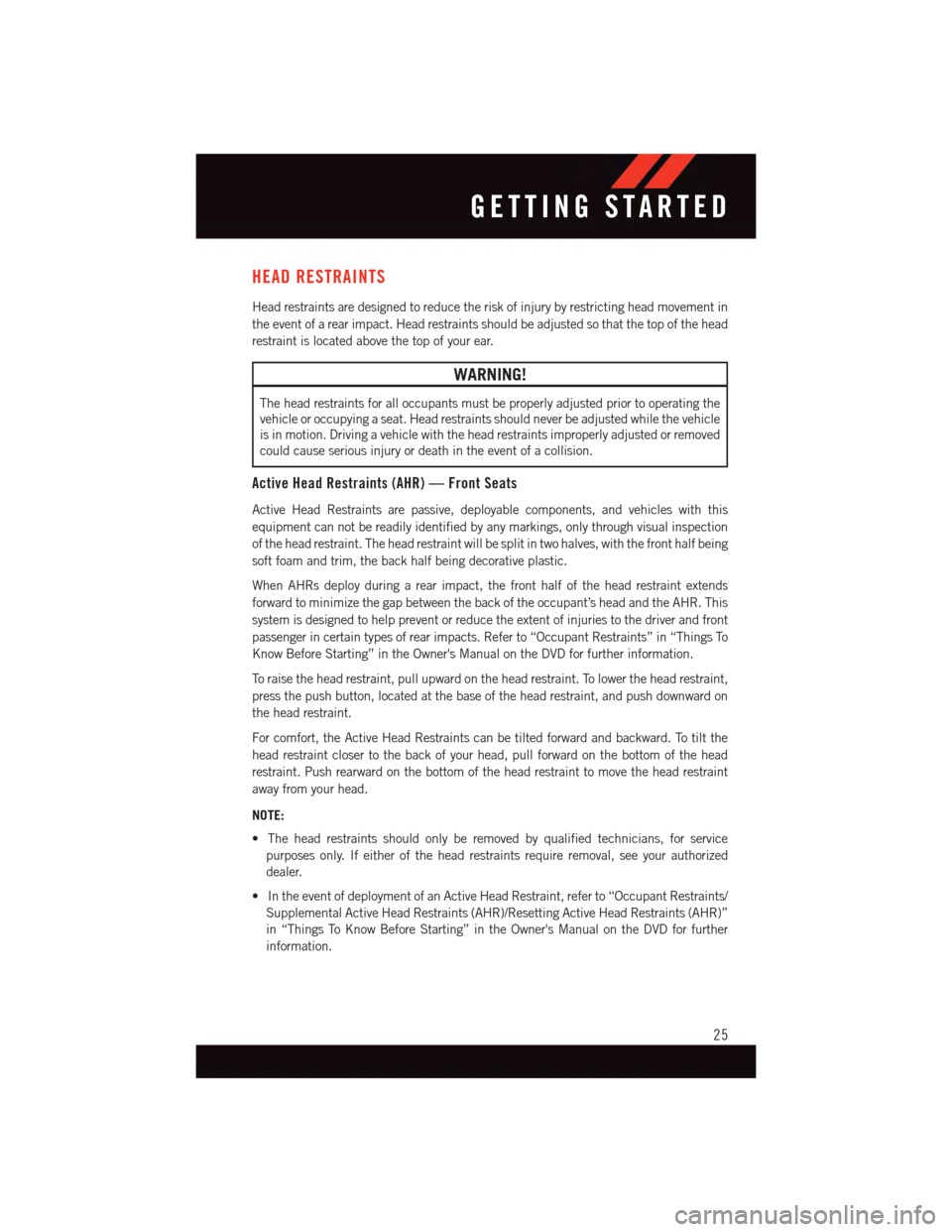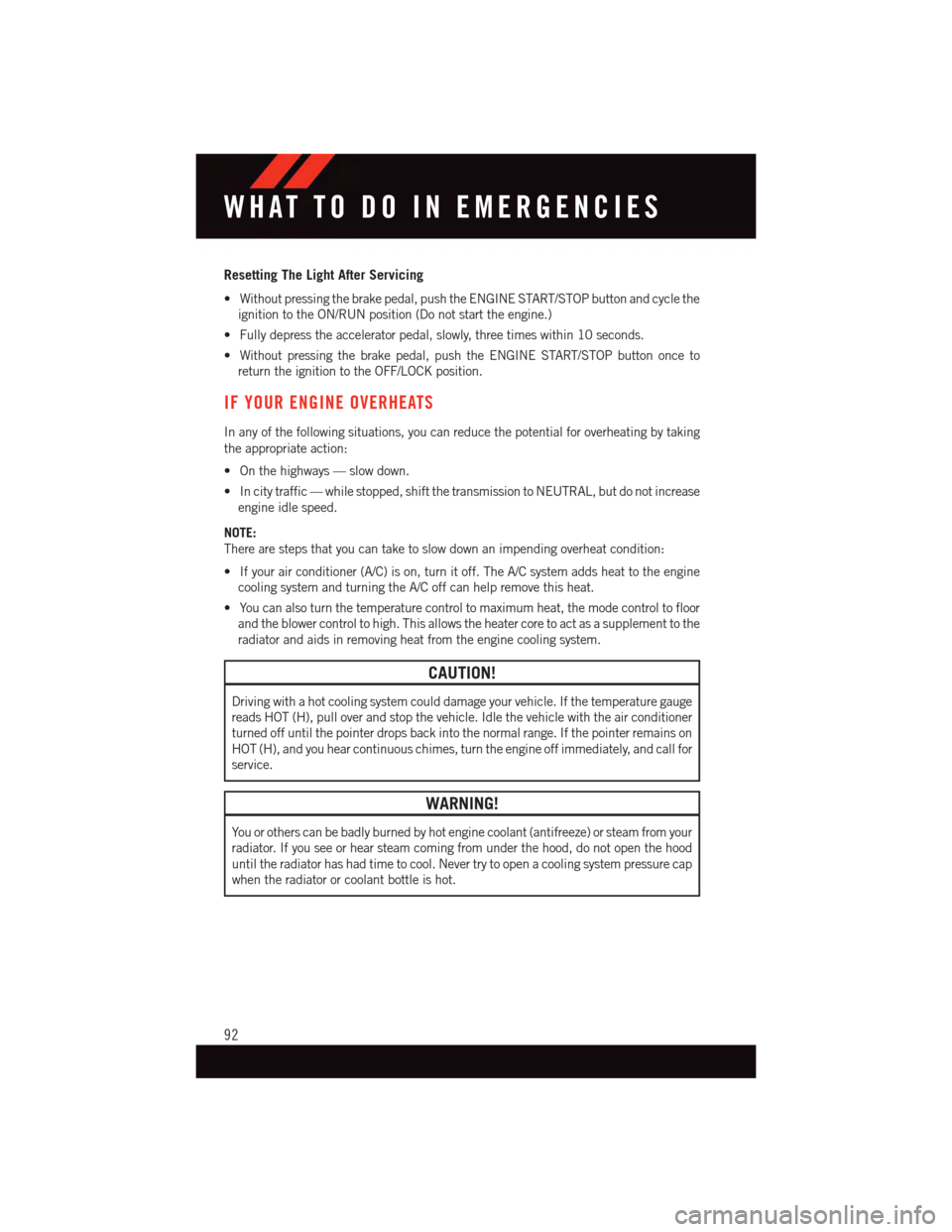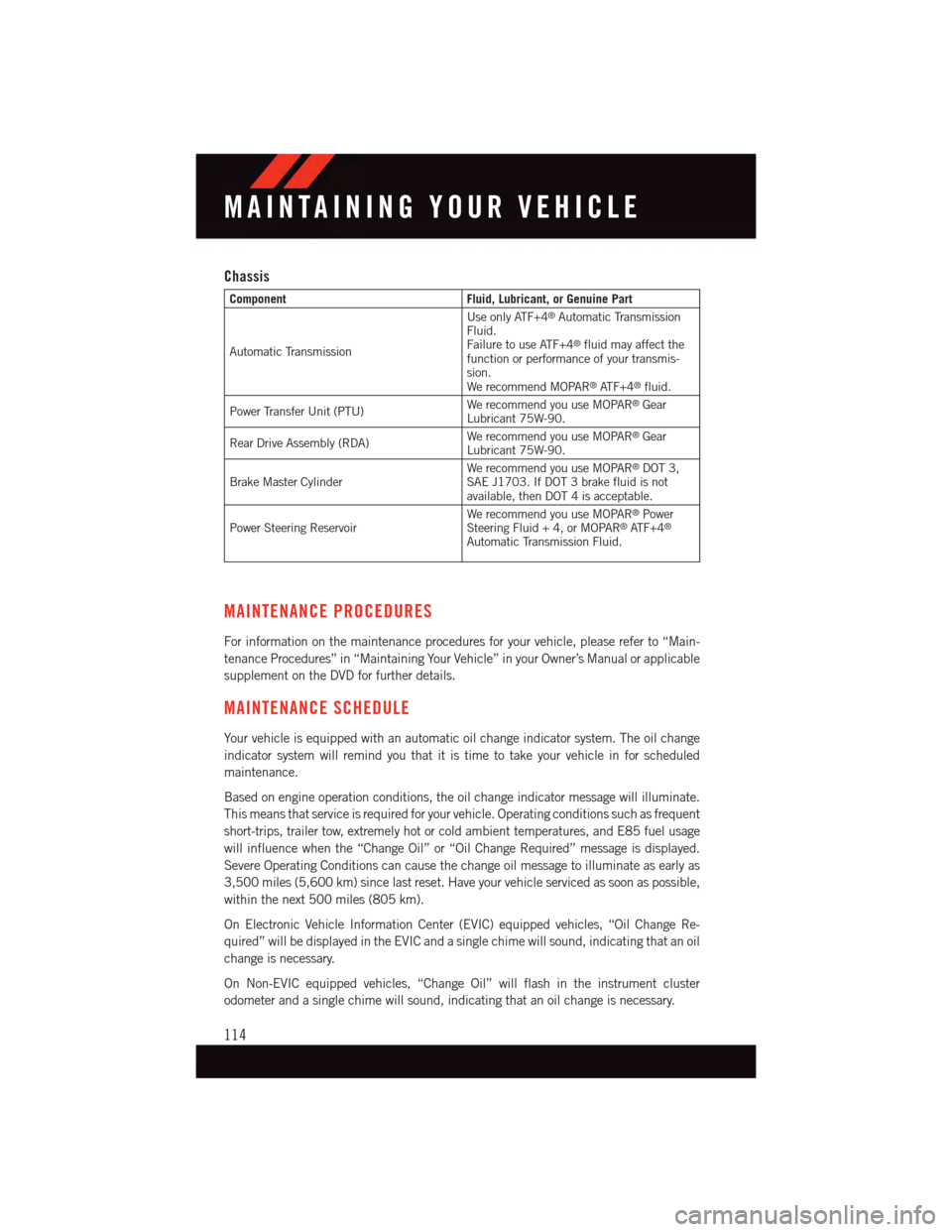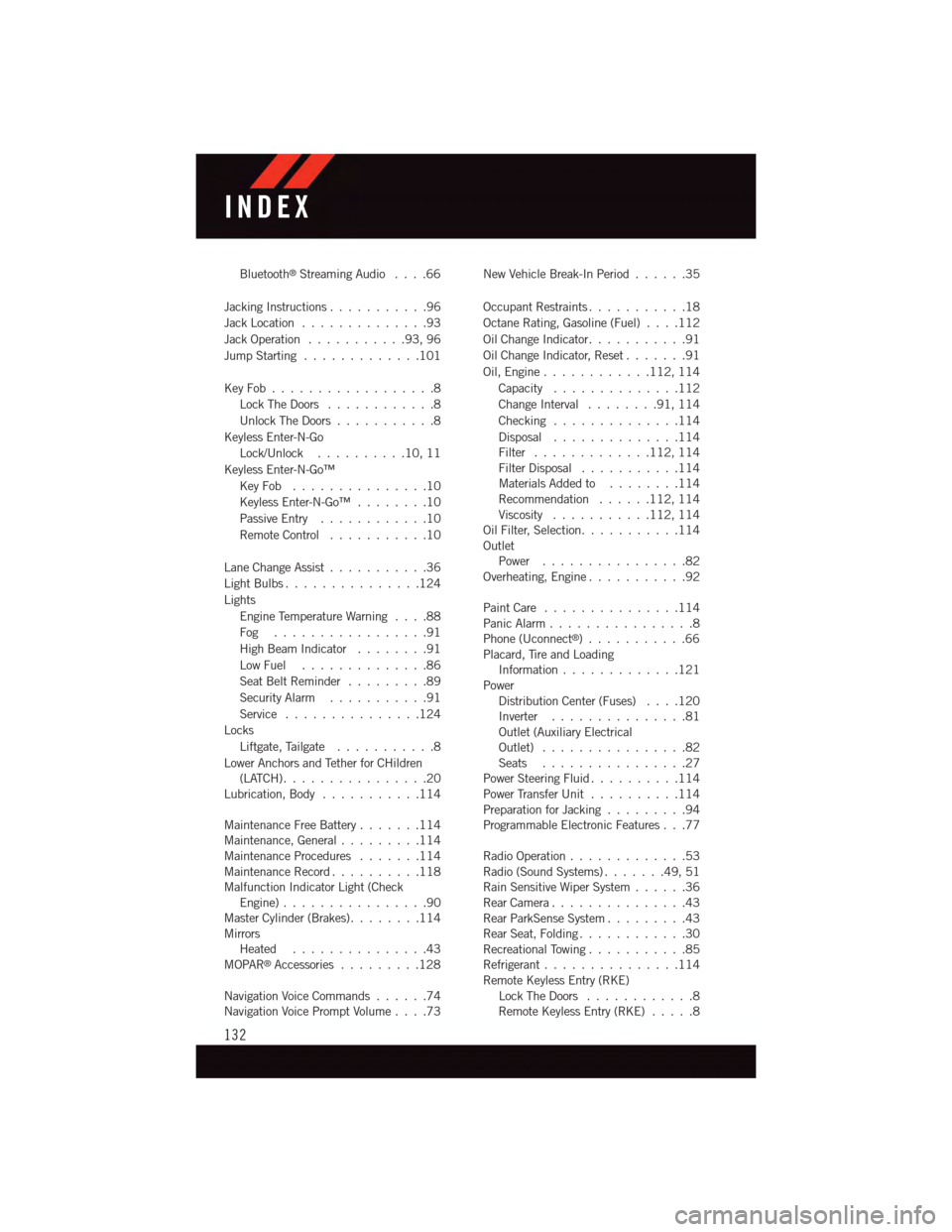service reset DODGE JOURNEY 2015 1.G User Guide
[x] Cancel search | Manufacturer: DODGE, Model Year: 2015, Model line: JOURNEY, Model: DODGE JOURNEY 2015 1.GPages: 140, PDF Size: 23.09 MB
Page 27 of 140

HEAD RESTRAINTS
Head restraints are designed to reduce the risk of injury by restricting head movement in
the event of a rear impact. Head restraints should be adjusted so that the top of the head
restraint is located above the top of your ear.
WARNING!
The head restraints for all occupants must be properly adjusted prior to operating the
vehicle or occupying a seat. Head restraints should never be adjusted while the vehicle
is in motion. Driving a vehicle with the head restraints improperly adjusted or removed
could cause serious injury or death in the event of a collision.
Active Head Restraints (AHR) — Front Seats
Active Head Restraints are passive, deployable components, and vehicles with this
equipment can not be readily identified by any markings, only through visual inspection
of the head restraint. The head restraint will be split in two halves, with the front half being
soft foam and trim, the back half being decorative plastic.
When AHRs deploy during a rear impact, the front half of the head restraint extends
forward to minimize the gap between the back of the occupant’s head and the AHR. This
system is designed to help prevent or reduce the extent of injuries to the driver and front
passenger in certain types of rear impacts. Refer to “Occupant Restraints” in “Things To
Know Before Starting” in the Owner's Manual on the DVD for further information.
To r a i s e t h e h e a d r e s t r a i n t , p u l l u p w a r d o n t h e h e a d r e s t r a i n t . To l o w e r t h e h e a d r e s t r a i n t ,
press the push button, located at the base of the head restraint, and push downward on
the head restraint.
For comfort, the Active Head Restraints can be tilted forward and backward. To tilt the
head restraint closer to the back of your head, pull forward on the bottom of the head
restraint. Push rearward on the bottom of the head restraint to move the head restraint
away from your head.
NOTE:
•Theheadrestraintsshouldonlyberemovedbyqualifiedtechnicians,forservice
purposes only. If either of the head restraints require removal, see your authorized
dealer.
•IntheeventofdeploymentofanActiveHeadRestraint,referto“OccupantRestraints/
Supplemental Active Head Restraints (AHR)/Resetting Active Head Restraints (AHR)”
in “Things To Know Before Starting” in the Owner's Manual on the DVD for further
information.
GETTING STARTED
25
Page 94 of 140

Resetting The Light After Servicing
•Withoutpressingthebrakepedal,pushtheENGINESTART/STOPbuttonandcyclethe
ignition to the ON/RUN position (Do not start the engine.)
•Fullydepresstheacceleratorpedal,slowly,threetimeswithin10seconds.
•Withoutpressingthebrakepedal,pushtheENGINESTART/STOPbuttononceto
return the ignition to the OFF/LOCK position.
IF YOUR ENGINE OVERHEATS
In any of the following situations, you can reduce the potential for overheating by taking
the appropriate action:
•Onthehighways—slowdown.
•Incitytraffic—whilestopped,shiftthetransmissiontoNEUTRAL,butdonotincrease
engine idle speed.
NOTE:
There are steps that you can take to slow down an impending overheat condition:
•Ifyourairconditioner(A/C)ison,turnitoff.TheA/Csystemaddsheattotheengine
cooling system and turning the A/C off can help remove this heat.
•Youcanalsoturnthetemperaturecontroltomaximumheat,themodecontroltofloor
and the blower control to high. This allows the heater core to act as a supplement to the
radiator and aids in removing heat from the engine cooling system.
CAUTION!
Driving with a hot cooling system could damage your vehicle. If the temperature gauge
reads HOT (H), pull over and stop the vehicle. Idle the vehicle with the air conditioner
turned off until the pointer drops back into the normal range. If the pointer remains on
HOT (H), and you hear continuous chimes, turn the engine off immediately, and call for
service.
WARNING!
Yo u o r o t h e r s c a n b e b a d l y b u r n e d b y h o t e n g i n e c o o l a n t ( a n t i f r e e z e ) o r s t e a m f r o m y o u r
radiator. If you see or hear steam coming from under the hood, do not open the hood
until the radiator has had time to cool. Never try to open a cooling system pressure cap
when the radiator or coolant bottle is hot.
WHAT TO DO IN EMERGENCIES
92
Page 116 of 140

Chassis
ComponentFluid, Lubricant, or Genuine Part
Automatic Transmission
Use only ATF+4®Automatic TransmissionFluid.Failure to use ATF+4®fluid may affect thefunction or performance of your transmis-sion.We recommend MOPAR®AT F + 4®fluid.
Power Transfer Unit (PTU)We recommend you use MOPAR®GearLubricant 75W-90.
Rear Drive Assembly (RDA)We recommend you use MOPAR®GearLubricant 75W-90.
Brake Master CylinderWe recommend you use MOPAR®DOT 3,SAE J1703. If DOT 3 brake fluid is notavailable, then DOT 4 is acceptable.
Power Steering ReservoirWe recommend you use MOPAR®PowerSteering Fluid + 4, or MOPAR®AT F + 4®
Automatic Transmission Fluid.
MAINTENANCE PROCEDURES
For information on the maintenance procedures for your vehicle, please refer to “Main-
tenance Procedures” in “Maintaining Your Vehicle” in your Owner’s Manual or applicable
supplement on the DVD for further details.
MAINTENANCE SCHEDULE
Yo u r v e h i c l e i s e q u i p p e d w i t h a n a u t o m a t i c o i l c h a n g e i n d i c a t o r s y s t e m . T h e o i l c h a n g e
indicator system will remind you that it is time to take your vehicle in for scheduled
maintenance.
Based on engine operation conditions, the oil change indicator message will illuminate.
This means that service is required for your vehicle. Operating conditions such as frequent
short-trips, trailer tow, extremely hot or cold ambient temperatures, and E85 fuel usage
will influence when the “Change Oil” or “Oil Change Required” message is displayed.
Severe Operating Conditions can cause the change oil message to illuminate as early as
3,500 miles (5,600 km) since last reset. Have your vehicle serviced as soon as possible,
within the next 500 miles (805 km).
On Electronic Vehicle Information Center (EVIC) equipped vehicles, “Oil Change Re-
quired” will be displayed in the EVIC and a single chime will sound, indicating that an oil
change is necessary.
On Non-EVIC equipped vehicles, “Change Oil” will flash in the instrument cluster
odometer and a single chime will sound, indicating that an oil change is necessary.
MAINTAINING YOUR VEHICLE
114
Page 134 of 140

Bluetooth®Streaming Audio....66
Jacking Instructions . . . . . . . . . . .96
Jack Location . . . . . . . . . . . . . .93
Jack Operation . . . . . . . . . . .93, 96
Jump Starting.............101
Key Fob . . . . . . . . . . . . . . . . . .8
Lock The Doors............8
Unlock The Doors...........8
Keyless Enter-N-Go
Lock/Unlock . . . . . . . . . .10, 11
Keyless Enter-N-Go™
Key Fob . . . . . . . . . . . . . . .10
Keyless Enter-N-Go™ . . . . . . . .10
Passive Entry............10
Remote Control...........10
Lane Change Assist...........36
Light Bulbs . . . . . . . . . . . . . . .124
Lights
Engine Temperature Warning....88
Fog . . . . . . . . . . . . . . . . .91
High Beam Indicator . . . . . . . .91
Low Fuel . . . . . . . . . . . . . .86
Seat Belt Reminder.........89
Security Alarm...........91
Service...............124
Locks
Liftgate, Tailgate . . . . . . . . . . .8
Lower Anchors and Tether for CHildren(LATCH)................20Lubrication, Body...........114
Maintenance Free Battery . . . . . . .114Maintenance, General.........114Maintenance Procedures.......114Maintenance Record..........118Malfunction Indicator Light (CheckEngine)................90Master Cylinder (Brakes)........114MirrorsHeated...............43MOPAR®Accessories.........128
Navigation Voice Commands......74Navigation Voice Prompt Volume....73
New Vehicle Break-In Period . . . . . .35
Occupant Restraints...........18
Octane Rating, Gasoline (Fuel)....112
Oil Change Indicator...........91
Oil Change Indicator, Reset.......91
Oil, Engine............112, 114
Capacity..............112
Change Interval........91,114
Checking..............114
Disposal..............114Filter.............112, 114Filter Disposal...........114Materials Added to........114Recommendation......112, 114Viscosity...........112, 114Oil Filter, Selection...........114OutletPower................82Overheating, Engine...........92
Paint Care . . . . . . . . . . . . . . .114Panic Alarm................8Phone (Uconnect®)...........66Placard, Tire and LoadingInformation . . . . . . . . . . . . .121PowerDistribution Center (Fuses)....120Inverter . . . . . . . . . . . . . . .81Outlet (Auxiliary ElectricalOutlet) . . . . . . . . . . . . . . . .82Seats................27Power Steering Fluid..........114Power Transfer Unit..........114Preparation for Jacking.........94Programmable Electronic Features . . .77
Radio Operation.............53Radio (Sound Systems).......49,51Rain Sensitive Wiper System......36Rear Camera...............43Rear ParkSense System.........43Rear Seat, Folding............30Recreational Towing...........85Refrigerant . . . . . . . . . . . . . . .114Remote Keyless Entry (RKE)Lock The Doors............8Remote Keyless Entry (RKE).....8
INDEX
132